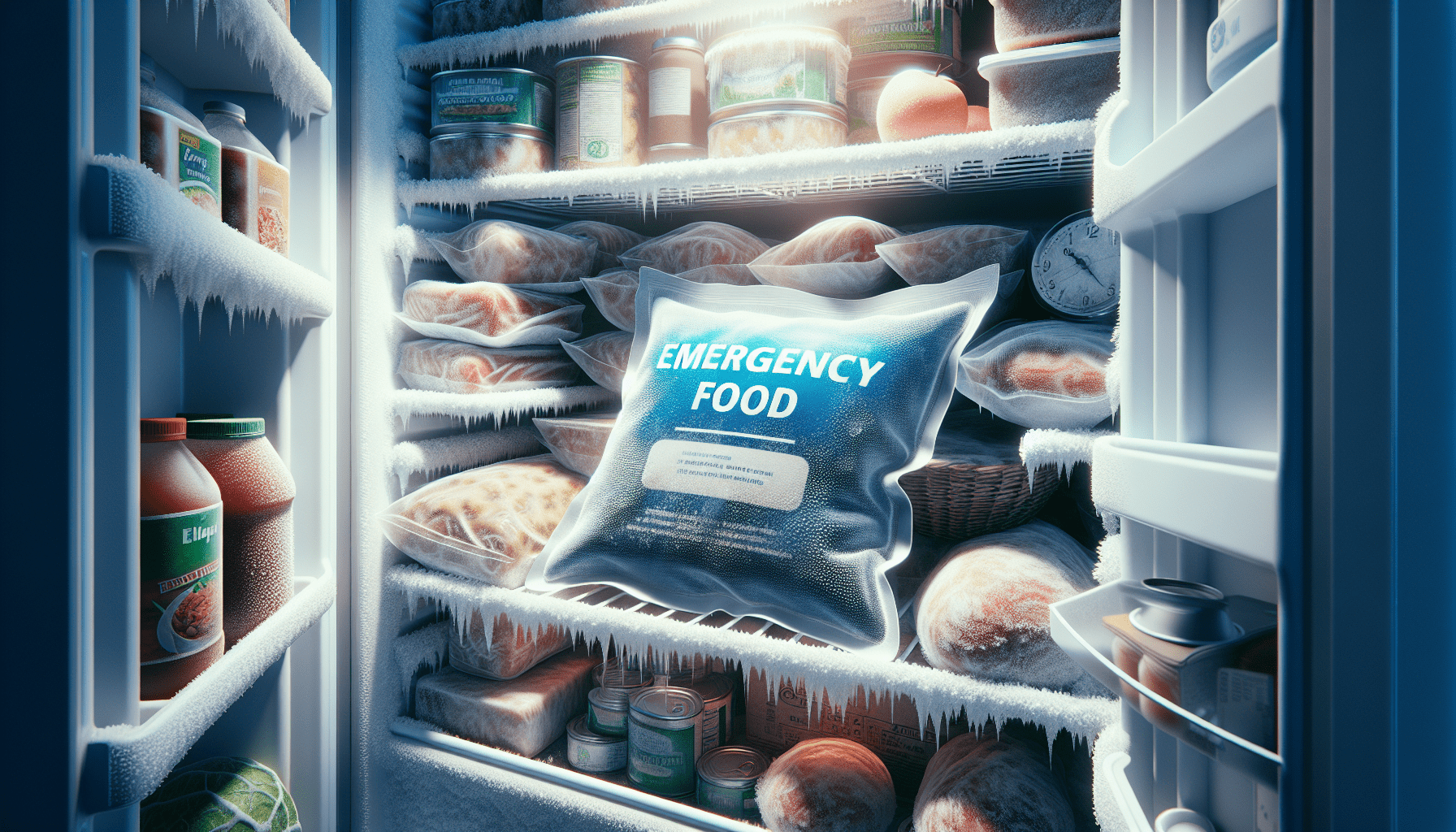Have you ever wondered if freezing emergency food can extend its shelf life? This is a common question that many people ask when planning for emergencies, natural disasters, or simply trying to maintain a stockpile of long-lasting food. Storing emergency food correctly is critical to ensure it stays safe and nutritious when you need it most.
Freezing food is a popular preservation method that many people use for everyday groceries, but how does it impact emergency food? Here, you’ll discover the ins and outs of this process, helping you make informed decisions about your food storage strategies.
What is Emergency Food?
Emergency food is designed to last longer than typical grocery store items and usually comes in non-perishable forms. These foods can be crucial during natural disasters, unexpected emergencies, or even economic difficulties that might limit your ability to purchase fresh food.
Types of Emergency Food
Different kinds of emergency food exist, each with unique advantages. Knowing what types of emergency food you have or might need can help in deciding how best to store them.
| Type | Description |
|---|---|
| Canned Food | Food items preserved by canning, which can last for years. Examples include beans, vegetables, and soup. |
| Dehydrated Food | Water is removed from these foods, increasing shelf life. Examples are dried fruits, vegetables, and meats. |
| Freeze-Dried Food | Food is quickly frozen, then dehydrated. It retains most nutrients and rehydrates easily. Examples include meals and snacks. |
| MREs | “Meals Ready-to-Eat” typically used by military personnel, with a long shelf life and suitable for immediate consumption. |
| Emergency Rations | High-calorie food bars designed to provide necessary nutrients in crisis situations. |
Understanding these types will help you make better decisions about how to store them, including whether freezing is a viable option.
How Freezing Affects Food Preservation
Freezing is a widely-used method for preserving food because it slows down enzyme activity and microbial growth, which are primary causes of food spoilage. However, the effectiveness and impact of freezing can vary depending on the type of food being frozen.
Benefits of Freezing Food
Freezing can significantly extend the life of food products. Here’s why it’s an effective preservation method:
- Reduces Bacterial Growth: Freezing slows the activity of bacteria and other microorganisms that can lead to spoilage.
- Preserves Nutrients: Freezing helps retain the nutritional content of food better than other preservation methods like canning or dehydrating.
- Maintains Flavor and Texture: Properly frozen food usually maintains its original flavor and texture when thawed and cooked.
Downsides of Freezing Food
While freezing has many benefits, it’s not a perfect solution for all types of foods and situations:
- Freezer Burn: Foods not properly packaged can develop freezer burn, affecting quality.
- Energy Consumption: Freezers require a consistent power supply, which might not be reliable during emergencies.
- Limited Space: Freezers have limited storage capacity, restricting the amount of emergency food you can store this way.

Is Freezing Suitable for All Types of Emergency Food?
Before deciding to freeze emergency food, consider whether it’s suitable for the specific type of food you have. Some emergency foods might not benefit much from freezing, while others might see their shelf life extended significantly.
Canned Food
Canned food is already designed to last for years without refrigeration, thanks to the canning process, which seals out air and bacteria.
- Suitability for Freezing: Low. Canned foods don’t benefit from freezing and the cans might burst under low temperatures, compromising the food.
Dehydrated and Freeze-Dried Food
These foods have had most water removed, which is a primary factor in spoilage.
- Suitability for Freezing: Moderate to High. Freezing can further extend their already long shelf life, especially if they are repackaged in vacuum-sealed bags.
MREs (Meals Ready-to-Eat)
Packed with a variety of items and designed to be shelf-stable, MREs usually have a substantial shelf life without needing special storage conditions.
- Suitability for Freezing: Low to Moderate. Freezing won’t harm them, but it’s not necessary for extending their shelf life.
Emergency Rations
These generally have a long shelf life and are packed to withstand many conditions.
- Suitability for Freezing: Low. Emergency rations don’t benefit much from freezing as they are designed to last long without it.
The Science Behind Freezing Food
Understanding the science behind freezing can help you make better decisions on whether to freeze your emergency food supplies.
How Freezing Works
When food is frozen, the water inside it forms ice crystals. The speed at which food is frozen affects the size of these crystals, which in turn affects the food’s texture and integrity upon thawing.
- Slow Freezing: This leads to the formation of large ice crystals, which can damage cell walls in the food, leading to mushy textures when thawed.
- Fast Freezing: Rapid freezing results in smaller ice crystals, which cause less damage and preserve texture better.
Impact of Initial Food Quality
The quality of food before freezing also plays a significant role. Food that is fresh and high in quality at the time of freezing will fare much better over time than food that is nearing spoilage.
Storage Temperature
Keeping a consistent, low temperature is crucial for maintaining the quality of your frozen food. The ideal temperature for freezing food is 0°F (-18°C) or lower.

Best Practices for Freezing Emergency Food
If you decide that freezing is a good option for extending the shelf life of your emergency food, following best practices can help ensure your food remains in excellent condition.
Packaging
Proper packaging is essential to prevent freezer burn and preserve food quality.
- Vacuum Sealing: This removes air from the packaging, reducing the risk of freezer burn and maintaining quality.
- Freezer-Safe Bags: Choose bags designed for freezing, as they are more durable and prevent moisture loss.
- Containers with Tight Seals: Use containers with airtight lids to keep your food fresh.
Labeling
Always label your frozen food with its contents and the date it was frozen. This helps you manage your stock and ensures you use items in the appropriate order.
Portion Control
Freeze food in manageable portions to make it easier to thaw and use as needed. This also reduces the risk of wasting food.
Thawing
Proper thawing is as important as freezing. Thaw frozen emergency food in the refrigerator rather than at room temperature to minimize the risk of bacterial contamination.
Common Myths About Freezing Emergency Food
Several myths about freezing food persist. Debunking these can help you make more informed decisions.
Myth: Freezing Kills All Bacteria
Freezing stops the growth of bacteria but doesn’t kill all of them. Once the food is thawed, any bacteria present can become active again.
Myth: Frozen Food Keeps Indefinitely
While freezing extends the shelf life of food, it doesn’t make it last forever. Over time, food quality can degrade even in the freezer.
Myth: All Foods Can Be Frozen
Not all types of food freeze well. Foods with high water content, like lettuce or cucumbers, don’t freeze well and will be mushy upon thawing.
Myth: Freezing Depletes Nutrients
Freezing preserves most of a food’s nutrients better than other preservation methods like canning, as long as the food is of high quality when frozen.

Alternative Methods to Extend Shelf Life
If freezing isn’t a viable option for all your emergency food, there are other methods to consider.
Vacuum Sealing
This method removes air from the packaging, slowing down degradation and preventing spoilage. It’s particularly effective for dehydrated and freeze-dried foods.
Oxygen Absorbers
When added to food storage containers, oxygen absorbers can significantly extend the shelf life by reducing the oxygen that bacteria and mold need to grow.
Mylar Bags
These bags, combined with oxygen absorbers, provide an excellent barrier against moisture, light, and oxygen, which are the main culprits in food spoilage.
Drying and Dehydration
Removing moisture from food inhibits the growth of bacteria and mold, significantly extending its shelf life. This method works well for fruits, vegetables, and some meats.
Making an Informed Decision
Freezing emergency food can be part of a robust food storage plan, but it’s not a one-size-fits-all solution. Considering the type of food, the conditions under which it will be stored, and the space available in your freezer will help you decide the best strategy.
Weighing Pros and Cons
Weighing the benefits and downsides of freezing emergency food is essential. Consider the following factors:
| Advantages | Disadvantages |
|---|---|
| Extends shelf life | Limited freezer space |
| Maintains nutritional value | Risk of freezer burn |
| Reduces microbial activity | Energy consumption |
| Preserves flavor and texture | Dependent on a consistent power supply |
Combining Methods
Often, combining different preservation methods offers the best results. For example, vacuum-seal foods before freezing them and use oxygen absorbers in another part of your storage to cover all bases.
Regular Rotation
Regardless of the method you choose, regularly rotating your stock ensures that your emergency food supply remains fresh and usable. Labeling and dating your food can help with this process.

Conclusion
Asking whether you can freeze emergency food to extend its shelf life opens up a broader conversation about food preservation strategies. While freezing can be an effective way to prolong the shelf life of certain types of emergency food, it’s not suitable for all. Understanding the specific needs of your emergency food and implementing best practices for freezing can help you build a reliable and long-lasting food supply.
In addition to freezing, exploring alternative methods like vacuum sealing and using oxygen absorbers can optimize your food storage and preparedness. By making informed decisions and combining various preservation methods, you’ll be better prepared to face any emergency with a well-maintained stockpile of nutritious food.

